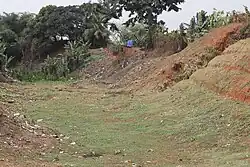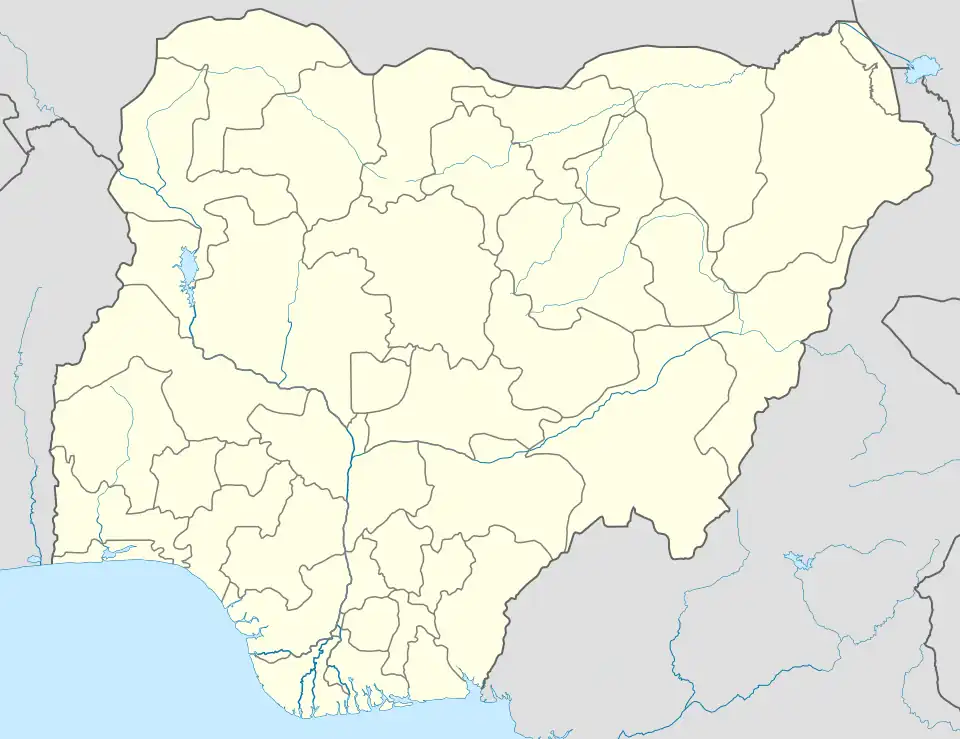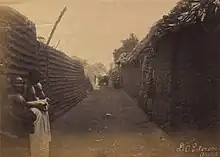Benin Moat
The Benin Moat, also known as the Benin Iya, Walls of Benin or locally as Iyanuwo,[1] are a series of massive earthworks encircling Benin City in Nigeria's Edo State. These moats have deep historical roots, with evidence suggesting their existence before the establishment of the Oba monarchy. Construction began around 800 AD and continued until 1460 AD, involving large-scale manual labour and the repurposing of earth from the inner ditch to build the outer berm. Some traditional sources claim that these earthworks spanned approximately 16,000 kilometres (9,900 mi), enclosing about 6,500 square kilometres (2,500 sq mi) of land.
| Benin Moat | |
|---|---|
| Native name Edo language: Iyanuwo | |
 | |
| Type | Defensive fortification |
| Location | Benin City, Edo State, Nigeria |
| Nearest city | Benin City |
| Coordinates | 6.3426°N 5.6204°E |
| Area | 814 acres (329 ha) |
| Elevation | 150 feet 1 inch (45.75 m) |
| Height | Varies (approximately 18 metres (59 ft)) |
| Length | Approximately 16,000 kilometres (9,900 mi) |
| Built | 13th century |
| Built by | Edo people |
 Location within Nigeria | |
The Benin Moat served as defensive structures, with steep banks and a berm to deter invaders. Access to the city was controlled through nine gates. Today, remnants of the moats can still be found in Benin City, although urbanisation and land disputes pose challenges to their preservation. Recognised for their historical significance, the Benin Moat was added as an extension to the existing World Heritage Site of the Royal Palaces of Abomey in 1995, but it is still awaiting official recognition by UNESCO, and were acknowledged by the Guinness Book of World Records in 1974 as one of the world's largest man-made structures by length, second only to China's Great Wall. It was described by Olfert Dapper in his book Description of Africa in 1668 as the Great Walls of Benin.
History
Background
The origins of the Benin Moats, also known as the Walls of Benin, cannot not be attributed to a single ruler or era.[2] While Oba Oguola played a role in expanding and deepening the moats, evidence suggests that these moats existed before his reign and even before the establishment of the Oba monarchy.[2] Various villages and wards that later coalesced into Benin City may have initially dug their moats for both defensive and boundary purposes.[3] The moat is an example of large-scale engineering characteristic of the Benin Empire.[4] It consisted of a combination of ramparts and intricate moats that encircled the city of Benin City in present-day Edo State, Nigeria.[5]
Construction
The earliest phase of moat construction in the Benin Kingdom likely predates the Ogiso kings. Archaeological findings and oral traditions suggest that some moats were in existence before the arrival of the Ogiso rulers.[6] These early moats served various purposes, including socio-political organisation, economic activities, and defense.[7]
During the rule of the Ogiso kings, the culture of moat construction continued and likely expanded. Moats varied in their origins and purposes. Different villages and wards within the Benin Kingdom had their moats, often constructed for distinct reasons. The Ogiso kings contributed to the development of some of these moats, maintaining control and organisation within the kingdom.[7] With the transition from the Ogiso kings to the Obas, the moat-building tradition persisted. Obas like Oba Oguola and Oba Ewuare re-dug and deepened some of these structures. The moats associated with the Benin Kingdom today, particularly the inner moat crossed during Obas' coronation, might have been deepened during Oba Ewuare's reign in 1440 A.D. Oba Oguola, who reigned around 1280 A.D, also played a role in moat construction.[7]
Construction of the Benin Moat itself began as early as 800 AD and continued until around 1460 AD.[8] This defensive system comprised inner moats and walls protecting Benin City, while outer walls extended to encompass numerous villages and communities.[8] In total, the moat system spanned about 16,000 kilometres (9,900 mi) and enclosed approximately 6,500 square kilometres (2,500 sq mi) of land.[8] Manual labour was the sole means of construction, precluding the use of modern earth-moving equipment or technology. Earth excavated to create the inner moat was repurposed to build the external ramparts (outer walls). These walls varied in size, from shallow traces to towering structures reaching up to 20 metres (66 ft) in height. The length of the Benin Moat ranks it among the most extensive earthworks in history.[9][10]
The moats, vigilantly guarded, functioned as effective defensive lines. They exposed invaders attempting to breach the city, resulting in their capture or meeting fierce resistance by Benin soldiers.[11] The steep earth banks posed an obstacle to invaders, who risked burial in sand avalanches. The towering walls discouraged climbing, making invaders targets for Benin soldiers armed with spears and poisoned arrows.[12] The outer walls provided an additional layer of protection, effectively shielding the city. Strict access control was maintained through nine gates in the city walls.[13] The inner wall, approximately 10 kilometres (6.2 mi) long, encircled vital areas, including the Royal Palace and chiefs' residences.[13] Beyond the inner wall lay a broad ditch, matching the wall's dimensions.[14] Access through this fortified earthwork required payment of a toll, contributing to the city's reputation for safety by subjecting visitors, including traders, to thorough scrutiny.[15][14]
Urban core and protective moats
The heart of Benin City's historical landscape under the Kingdom of Benin covered an area exceeding 7 square kilometres (2.7 sq mi). It included the residences of the Oba (king), nobility, and indigenous inhabitants.[16] The city's layout revolved around two perpendicular streets: the principal sacred king's palace passage extending from the palace to the east, and a cross street connecting the King's Square to Oba Market, where slaves and ivory were traded.[17] The city's various communities extended along these streets and other minor ones.[18] The Benin Moat, possibly originally over thirty-five feet in width, surrounded the city and acted as a protective barrier.[19] The moat maintained a consistent depth, an average width exceeding thirty-five to fifty feet, and a length over 13,000 miles (21,000 km).[20]
There were two distinct sections of the moat: the primary moat around the urban core and the sacred palace, and a secondary moat constructed later, encircling an area to the south.[21] These moats were complemented by a defensive wall constructed of limestone blocks. Together, the moats and walls constituted defenses.[20]
Current state

The British punitive expedition in 1897, which heavily damaged the Benin Moat, and the expansion of Benin City has encroached upon and obscured remnants of the rural earthworks. Additionally, some locals have repurposed these materials for construction purposes.[11][9] Traces of these ancient moats persist, visible as tree-lined embankments woven into the contemporary cityscape.[20][9]
The moats encircling various towns and villages in Benin Metropolis historically served as boundaries. In many cases, these moats now encompass multiple villages, leading to complexity in areas like Benin City due to urban expansion and ongoing development for housing and industrial purposes.[8] As a result, some villages assert ownership claims over parts or the entirety of the moat enclosures, citing their longstanding presence in the area, even if it means displacing the original inhabitants.[3] Such claims have sometimes resulted in conflicts and disruptions in the region, where the interests of long-standing settlers have clashed with those of newer, more populous arrivals.[2] Land disputes in the courts often involve clashes between the original owners of Iya or moats enclosures and newer settlers claiming ancestral rights.[7]

Portions of the moats have yielded to residential and commercial development, experienced degradation from drainage projects, and been transformed into refuse disposal sites.[22] Certain sections of the moats, such as the area near Ogba Road, have succumbed to pollution and serve as dumping grounds for waste.[23] Preserving these historical assets necessitates comprehensive programs encompassing documentation, preservation, and vigilant safeguarding.[24]
Legacy
European explorers first learned of the Benin Walls in 1472 AD when Portuguese explorer Duarte Pacheco Pereira made a brief mention of them during his travels, describing it as a city a league wide and defended by a moat.[25] However, archaeologist Graham Connah later cast doubt on Pereira's depiction, suggesting that Pereira might not have considered an earthen bank as a wall within the context of his time.[26] In the early 1600s, Dutch explorer Dierick Ruiters also noted the fortifications, describing the earthworks, moat, and well-guarded gate.[27]
One of the earliest accounts of the Walls of Benin was given by Olfert Dapper, a Dutch physician and writer who published a book titled Description of Africa in 1668.[28] Dapper never visited Africa himself, but he compiled his book from the reports of Dutch travellers and missionaries who had explored various regions of the continent. He devoted a chapter to the Benin Kingdom at page 495 of his book, where he described its culture, politics, religion, and architecture. He mentioned the Walls of Benin as one of the remarkable features of the kingdom, saying that they were four times longer than the Great Wall of China.[28]
In 1974, the Guinness Book of World Records recognised the walls of Benin City as the world's second-largest man-made structure by length, following China's Great Wall. The series of earthen ramparts was acclaimed as the most extensive earthwork ever constructed.[9] In 1995, the Benin Moat, alongside Sungbo's Eredo, was added as an extension to the existing World Heritage Site of the Royal Palaces of Abomey, but it is still awaiting official recognition by UNESCO.[29][30]
References
- Ebegbulem, Simon (25 March 2011). "National monument,Benin moat...On the edge of extinction". Vanguard News. Retrieved 12 October 2023.
- "Benin Moat: Amazing legacy of great people". The Nation Nigeria. 21 May 2013. Retrieved 25 August 2023.
- Ebegbulem, Simon (25 March 2011). "National monument,Benin moat...On the edge of extinction". Vanguard News. Retrieved 18 September 2023.
- Onokerhoraye 1975, pp. 299–300.
- Nevadomsky, Lawson & Hazlett 2014, pp. 59–85.
- "The Great Wall of Benin — Giving Children a Fighting Chance". SchoolForAfrica.org. 28 February 2021. Retrieved 18 September 2023.
- "The Benin Moats". edoworld.net your Guide To The Benin Kingdom & Edo State, Nigeria. 1 July 2021. Retrieved 18 September 2023.
- Ogundiran, Akinwumi (June 2005). "Four Millennia of Cultural History in Nigeria (ca. 2000 B.C.–A.D. 1900): Archaeological Perspectives". Journal of World Prehistory. 19 (2): 133–168. doi:10.1007/s10963-006-9003-y. S2CID 144422848.
- Koutonin, Mawuna (18 March 2016). "Story of cities #5: Benin City, the mighty medieval capital now lost without trace". The Guardian. Retrieved 2 April 2018.
- MacEachern, Scott (January 2005). "Two thousand years of West African history". African Archaeology: A Critical Introduction. Academia: 18–23.
- Connah 1967, pp. 593–609.
- Daerego, Mary M.K. (6 August 2020). "GRANDEUR OF THE BENIN MOAT (ancient Benin civilization)". Observe Nigeria. Retrieved 18 September 2023.
- Graham 1965, pp. 317–334.
- "Benin's ancient moat wall turned dumpsite". Tribune Online. 16 June 2021. Retrieved 25 August 2023.
- Trammell, Victor (20 September 2020). "Pre-Colonial Africa's Benin Moat Was Much Wider & Longer Than China's Great Wall". Black Then. Retrieved 25 August 2023.
- "HOME – BENIN MOAT FOUNDATION". beninmoatfoundation.org. 25 July 2011. Archived from the original on 3 March 2012. Retrieved 8 September 2023.
- Carvajal, Guillermo (17 October 2016). "Las murallas de Benin, la estructura más larga construída por el hombre, con 16.000 kilómetros de longitud". La Brújula Verde (in European Spanish). Retrieved 8 September 2023.
- Readman, Kurt (17 January 2022). "Mysterious and Massive: Who Built the Walls of Benin?". Historic Mysteries. Retrieved 25 August 2023.
- @NatGeoUK (17 September 2022). "The story of Nigeria's stolen Benin Bronzes, and the London museum returning them". National Geographic. Retrieved 8 September 2023.
- Affairs, Edo (21 February 2023). "The Benin Moat – Largest Man Made Earthworks". Edoaffairs. Retrieved 8 September 2023.
- Team, Editorial (19 November 2018). "The Ancient Walls of Benin: 16,000 Kilometres (800AD-14th Century)". Think Africa. Retrieved 25 August 2023.
- Maduka 2014, pp. 83–106.
- Adekola et al. 2021.
- Onwuanyi, Nwodo & Chima 2021, pp. 21–39.
- Hodgkin, Thomas (1960). Nigerian Perspectives: An Historical Anthology. Oxford University Press. p. 93. ISBN 978-0-19-215434-7.
- Connah 1972, pp. 25–38.
- Hodgkin, Thomas (1960). Nigerian Perspectives: An Historical Anthology. Oxford University Press. p. 120. ISBN 978-0-19-215434-7.
- Dapper, Olfert; Jones, Adam (1998). Olfert Dapper's description of Benin (1668). Madison, Wis.: African Studies Program, University of Wisconsin-Madison. p. 495. ISBN 978-0-942615-34-0. OCLC 39399011.
- Centre, UNESCO World Heritage. "Benin Iya / Sungbo' s Eredo". UNESCO World Heritage Centre. Retrieved 25 August 2023.
- "Benin Iya". worlds longest ancient earthworks. Retrieved 12 October 2023.
Bibliography
- Willett, Frank (1985). African Art: An Introduction (Reprint. ed.). New York: Thames and Hudson. ISBN 0-500-20103-X.
- Connah, Graham (1972). "Archaeology in Benin". The Journal of African History. Cambridge University Press. 13 (1): 25–38. doi:10.1017/s0021853700000244. ISSN 0021-8537. S2CID 162976770.
- Connah, Graham (24 September 1967). "New Light on the Benin City Walls". Journal of the Historical Society of Nigeria. Historical Society of Nigeria. 3 (4): 593–609. ISSN 0018-2540. JSTOR 41856902. Retrieved 18 September 2023.
- Graham, James D. (1965). "The Slave Trade, Depopulation and Human Sacrifice in Benin History". Cahiers d'études africaines (in French). PERSEE Program. 5 (18): 317–334. doi:10.3406/cea.1965.3035. ISSN 0008-0055.
- Maduka, Chukwugozie (2014). "Preserving the Benin City Moats: The Interaction of Indigenous and Urban Environmental Values and Aesthetics". Environmental Ethics. Philosophy Documentation Center. 36 (1): 83–106. doi:10.5840/enviroethics20143616. ISSN 0163-4275.
- Onwuanyi, Ndubisi; Nwodo, Geoffrey; Chima, Pius (2021). "The Benin City Moat System: Functional Space Or Urban Void?". Coou African Journal of Environmental Research. 3 (1): 21–39. ISSN 2714-4461. Retrieved 18 September 2023.
- Adekola, P. O.; Iyalomhe, F. O.; Paczoski, A.; Abebe, S. T.; Pawłowska, B.; Bąk, M.; Cirella, G. T. (11 January 2021). "Public perception and awareness of waste management from Benin City". Scientific Reports. Springer Science and Business Media LLC. 11 (1): 306. doi:10.1038/s41598-020-79688-y. ISSN 2045-2322. PMC 7801630. PMID 33432016.
- Onokerhoraye, Andrew Godwin (1975). "Urbanism as an organ of traditional African civilization : The example of Benin, Nigeria / L'URBANISME, INSTRUMENT DE LA CIVILISATION AFRICAINE TRADITIONNELLE : L'EXEMPLE DE BENIN, NIGERIA". Civilisations. Institut de Sociologie de l'Université de Bruxelles. 25 (3/4): 294–306. ISSN 0009-8140. JSTOR 41229293. Retrieved 25 September 2023.
- Nevadomsky, Joseph; Lawson, Natalie; Hazlett, Ken (2014). "An Ethnographic and Space Syntax Analysis of Benin Kingdom Nobility Architecture". The African Archaeological Review. Springer. 31 (1): 59–85. doi:10.1007/s10437-014-9151-x. ISSN 0263-0338. JSTOR 43916862. S2CID 254187721. Retrieved 25 September 2023.
- "The British Conquest of Benin and the Oba's Return". The Art Institute of Chicago.
- Pearce, Fred (11 September 1999). "The African queen". New Scientist.